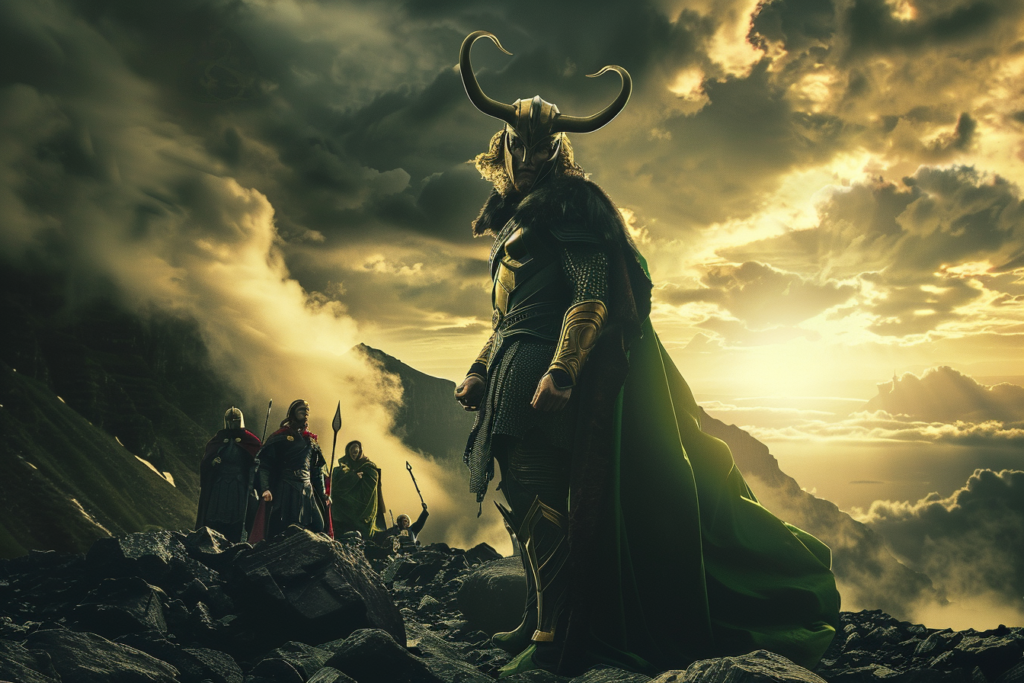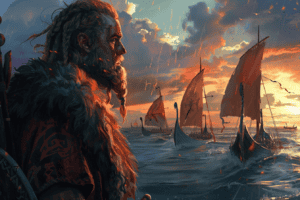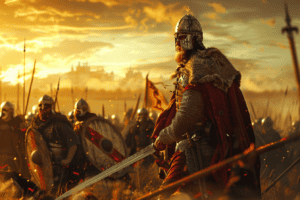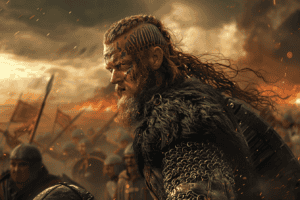In Norse mythology, Loki, the shape-shifter and cunning trickster god, emerges from the lineage of giants Fárbauti and Laufey.
His intricate character embodies chaos, pivotal in weaving together Aesir gods and giants. With Sigyn and Angrboða, Loki fathers Hel, Fenrir, and Jörmungandr, shaping the mythos profoundly.
His deceptive nature leads to chaos, seen in the demise of Baldr and the theft of Mjölnir. Loki’s unparalleled shape-shifting talents blur lines of allegiance, challenging norms.
Loki’s Origins and Family Connections

Loki’s lineage, tracing back to the giants Fárbauti and Laufey, reveals his unique heritage in Norse mythology. His character is deeply intertwined with his family connections, showcasing a complex blend of chaos within his origins. Within the intricate web of relationships in Norse mythology, Loki’s role is pivotal due to his multifaceted nature and his ties to both the Aesir gods and the giants.
Loki’s actions and his family connections are central to understanding his place in Norse mythology. The offspring he fathered with Sigyn and Angrboða, including Hel, Fenrir, and Jörmungandr, highlight the complex relationships he maintains. These eerie progeny play significant roles in the myths, shaping the narrative with their presence.
Exploring Loki’s origins and family connections provides a deeper insight into the complexity of his character and the impact he’s on the Norse pantheon. His unique heritage sets the stage for the multifaceted nature of the trickster god, showcasing a blend of chaos that reverberates throughout the tales of Norse mythology.
Loki’s Cunning and Deception

With his cunning wit and masterful deceit, Loki navigates the domain of gods and giants with unparalleled skill and guile. Loki’s cunning and deception play a central role in Norse mythology, shaping the intricate web of his character. His unpredictable nature and multifaceted abilities as a shape-shifter allow him to outsmart even the most powerful beings. However, Loki’s deceptive actions have had far-reaching consequences.
One of the most notorious instances of Loki’s trickery was his involvement in the death of Baldr, the beloved son of Odin. By orchestrating Baldr’s demise, Loki sowed discord among the gods, leading to chaos and conflict. Moreover, Loki’s theft of Mjölnir, Thor’s mighty hammer, further showcases his deceptive prowess and penchant for causing mayhem.
Despite his mischievous nature, Loki’s pivotal role in Norse mythology can’t be overlooked. His cunning and deceit add layers of complexity to the tales of gods and giants, making him a fascinating and enigmatic figure in the pantheon of Norse deities.
Loki’s Shape-Shifting Abilities

Among the intriguing aspects of Norse mythology is Loki’s remarkable talent for shape-shifting, enabling him to assume various forms with deceptive ease. His shape-shifting abilities allow him to transform into different animals, genders, and objects, showcasing his adaptability and resourcefulness.
One of the most famous tales involving Loki’s shape-shifting is when he turned into a mare and gave birth to Sleipnir, Odin’s eight-legged horse. This act highlights Loki’s deceptive and unpredictable nature, adding layers to his character as a masterful trickster.
The ability to change forms effortlessly contributes to Loki’s reputation as a figure of intrigue in Norse folklore, where his transformations blur the lines between ally and adversary, friend and foe. Loki’s shape-shifting is a key aspect of his persona, emphasizing his cunning and his skill for maneuvering situations with unpredictable flair, making him both a captivating and enigmatic character in Norse mythology.
Loki’s Relationships With Norse Deities
Interacting with Odin and Thor in Norse mythology, Loki’s relationships with the Norse deities reveal a complex tapestry of loyalty, betrayal, and camaraderie. Loki’s interactions with Odin and Thor are marked by an unpredictable nature, where he can switch allegiances for his own gain.
Despite his trickster reputation, Loki’s connections with deities like Odin and Thor showcase a nuanced web of alliances and conflicts within the domain of Norse mythology. Sometimes aiding, sometimes challenging, Loki plays a pivotal role in shaping the narrative of the pantheon.
The dynamics between Loki and other Norse gods add depth to the mythological stories, illustrating his role as a multifaceted character capable of both loyalty and betrayal. Through his relationships with Odin and Thor, Loki embodies the intricacies of divine interactions in Norse mythology, highlighting the intricate balance between camaraderie and conflict within the pantheon.
Loki’s Role in Key Mythological Events

Loki’s pivotal involvement in key mythological events shapes the course of Norse mythology, showcasing his influence on significant narratives and outcomes. His disruptive nature is evident in the theft of Thor’s hammer, Mjölnir, a deed that plunged the Norse pantheon into chaos and highlighted Loki’s ability to sow discord among the Aesir.
Moreover, Loki’s role in the death of Baldr, a beloved god, triggered a chain of events that led to profound consequences within the divine domain. The kidnapping of Idun, the goddess of youth, further emphasizes Loki’s capacity for causing turmoil and unrest.
Furthermore, Loki’s contributions to both constructive and destructive acts are exemplified by his assistance in building Asgard’s impregnable walls. These actions underscore the complex nature of the Norse trickster god and his significance in shaping the mythological landscape.
Loki’s Influence on Modern Culture

Loki’s impact on modern culture is undeniable, influenced markedly by his portrayal in Marvel Comics and the Marvel Cinematic Universe. Tom Hiddleston’s charismatic depiction of Loki hasn’t only amassed a massive fan following but has also solidified the character’s popularity in contemporary media.
The modern adaptations of Loki portray him as a complex character, exploring themes of redemption, antiheroism, and identity discovery. Audiences are drawn to Loki’s evolution, as he navigates intricate personality traits and engages in compelling narratives that resonate with viewers on a profound level.
Through the Marvel Cinematic Universe, Loki has become more than just a villain; he embodies the essence of an antihero with layers that continue to intrigue and captivate audiences worldwide. The examination of Loki’s multifaceted nature in popular culture has transformed him into a symbol of complexity and depth, showcasing the character’s enduring relevance and magnetism in modern storytelling.
Loki’s Moral Ambiguity
In his actions that shift between aiding and betraying the gods of Asgard, Loki’s moral ambiguity shines through. Loki’s character is a rich tapestry woven with the complexity of mischief and trickery. His actions, such as the role in Baldr’s death and the assistance in building Asgard’s protective walls, reflect the depth and complexity of Loki.
This multifaceted nature adds layers to Loki’s character, showcasing his mischievous nature alongside moments of loyalty and helpfulness to his fellow gods. Loki’s intricate relationships with the gods of Asgard further highlight his unpredictable and morally gray decisions.
The interplay of mischief and trickery in Loki’s deeds challenges traditional notions of heroism and villainy in Norse mythology. As you explore the intricate web of Loki’s actions, his moral ambiguity becomes a central aspect of his enigmatic persona, making him a compelling figure in Norse mythology.
Loki’s Symbolism and Archetype
Symbolizing disruption and chaos in Norse mythology, Loki embodies the archetype of the trickster with his shape-shifting abilities reflecting intricacies and constantly evolving nature. As a symbol of the trickster archetype, Loki blurs the lines between good and evil, challenging societal norms through his transformative actions. His fluid identity mirrors the unpredictable nature of life, where boundaries between reality and illusion are continually in flux. Loki’s deceptive nature serves as a reminder of the intricacies of human behavior and the fluid veil separating order from disorder.
Through his shape-shifting abilities, Loki embodies the essence of transformation, highlighting the constantly shifting landscape of existence in Norse mythology. His actions provoke thought on the duality of motives and the fine line between mischief and malevolence. By defying expectations and societal conventions, Loki challenges the status quo, encouraging introspection on the nature of morality and the consequences of embracing chaos.
Loki’s Legacy in Norse Mythology

With his lasting impact on Norse mythology, Loki’s legacy embodies the essence of trickery and transformation, shaping the intricate tapestry of mythological lore. As a shape-shifting trickster god, Loki’s enigmatic nature and complex relationships with other Norse deities enrich his legacy in the mythological domain. His involvement in key events such as the death of Baldr and the theft of Thor’s hammer, Mjölnir, solidifies his position as a pivotal figure in Norse mythology. The offspring of Loki, including Hel, Fenrir, and Jörmungandr, play significant roles in perpetuating his enduring impact on the mythological landscape.
The binding of Loki as retribution for his actions not only serves as punishment but also sets the stage for Ragnarök, the apocalyptic battle in Norse mythology. This event highlights Loki’s lasting influence and the consequences of his trickery within the divine sphere. Loki’s legacy is a testament to the intricate and sometimes dark intricacies of the Norse pantheon, showcasing the multifaceted nature of this infamous deity.










Add Comment